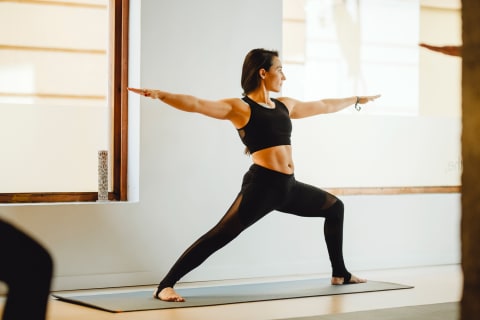Leg Position Basics Family Tree #1: Tadasana or Mountain Pose In tadasana, both hips are internally rotated. When you have achieved the “perfect” tadasana, your inner thighs will feel as if they are energetically rotating back behind you, and your shins will feel as if they are energetically hugging in to the midline of the body. Since the legs are symmetrical in tadasana, this family tree classification is “symmetrical internal.” Other poses with this position include: Family Tree #2: Virabhadrasana I or Warrior I In virabhadrasana I, both hips are internally rotated. Yep, this can be confusing, but now you know! Just like tadasana, the fullest expression of this pose will have you feeling as if your inner thighs are reaching back and your shins are hugging in. The key difference here, though, is one leg is forward with the knee flexed at a 90 degree angle (or as close as you can get) and the second leg is extended back. This means the legs are asymmetrical. This family classification, then, is “asymmetrical internal.” Other poses with this position include: Family Tree #3: Virabhadrasana II or Warrior II In virabhadrasana II, both hips are externally rotated. Again, this one can be tricky, but here the fullest expression is reached when the outer hips and thighs feel as though they are wrapping down toward the ground, and the inner thighs feel as if they are pulling in and up. In warrior II, the front leg is flexed forward with the knee bent as close to 90 degrees as possible and the back leg is extended straight. This leaves you in an asymmetrical position, so the classification for this family tree is “asymmetrical external.” Other poses in this family include: Family Tree #4: Temple Pose The final family tree is often forgotten. Temple pose is a great example of this posture. In temple, both outer hips are wrapping down, and both feet are grounded with the knees flexed as close to 90 degrees as possible. The classification for this tree is “symmetrical external.” Other poses in the family include: What happens when I lift my leg? There are some poses where one leg will be internally rotated and the other will be externally rotated. In most cases, this will occur when one leg is lifted off the ground or otherwise not bearing weight. For example, bird of paradise allows for internal rotation of the grounded hip and external rotation of the lifted hip. Tree pose allows for the same. Anytime a leg is lifted off the ground or otherwise not bearing weight, it is in what yoga teachers call an “open chain” position. This is just a fancy word used to describe a hip that can be freely moved about because it is not supporting the body. The discussion of open and closed chain movement is extensive, but the basic rule is: when a hip is in an open chain position, you can transition it between internal and external rotation without injury. As a result, it is not as crucial to stick with one family during this portion of your practice. Take it to the mat Plan a home practice using the family trees. Try to incorporate all of the trees into your practice, but group poses in one tree together. Allow yourself to transition between trees with a “vinyasa” or a return to a resting pose such as down dog or child’s pose. In doing so, you will create a practice your hips will thank you for.



